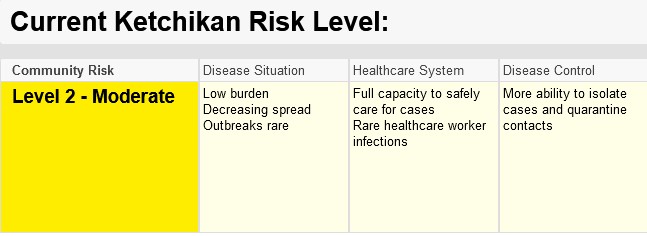
An excerpt from a document illustrating Ketchikan’s pandemic threat level. The indicator moved from “low” to “moderate” Friday as three recent Ketchikan cases were classified as “community spread.” (Screenshot by Eric Stone/KRBD)
Ketchikan’s pandemic risk ticked up from “low” to “moderate” Friday after state authorities classified three recent COVID-19 infections as cases of “community transmission.”
Local authorities are asking businesses to reduce their capacity — but the increased threat level isn’t expected to affect Ketchikan students’ return to full-capacity classrooms.
Community transmission, or community spread — that’s the term epidemiologists use when they can’t track down where a patient caught the coronavirus.
As Ketchikan emergency manager Abner Hoage explains, three cases may not seem like a lot…
“But as you look at the source of those cases being community transmission, and when you understand what that means, it’s a little more important, or a little riskier category than, say, just the overall number of cases,” Hoage said in a phone interview Friday.
That’s because of what the term “community transmission” implies.
“If you think about that, what that means is for each case of community spread, there’s at least one other person somewhere out there who’s infected that we don’t know about,” Hoage said.
The three people diagnosed with COVID-19 are employees at the Ketchikan Indian Community Tribal Health Clinic, according to the federally-recognized tribe. And, of course, it’s possible that all three caught the coronavirus from the same person.
“But Public Health couldn’t say that definitively. And so we have to go on the worst-case assumption, which is that there’s three other cases of positive infection out there that we don’t know about that could still be spreading within the community.
Last month, Ketchikan’s emergency operations center rolled out a data-driven tool that assesses the area’s pandemic threat level — and the three recent community spread cases bumped the level from “low,” or level one, to “moderate,” or level two.
And with the change in threat level come new recommendations for businesses, Hoage said.
“At level one, restaurants and gyms and offices and everything can open fully at 100%. We know in some locations that 100% doesn’t really allow for good social distancing. So we’re asking businesses to take that step to make sure that they reduce their capacity on their own, to a level that allows them to maintain that distancing,” he said.
Some of Hoage’s other recommendations include requiring reservations at restaurants — and appointments at salons. He says those steps would make future outbreaks easier to track.
An important note, though — they’re recommendations, not mandates.
“Each person is going to have to evaluate what actions they’re going to take on their own, but in general, what we’re asking people to do is be aware that there’s a higher risk currently,” Hoage said.
Hoage said he’s asking residents to step up their hand-washing, mask-wearing and social distancing. And he’s asking residents to keep their outdoor gatherings to 100 people at max — or 50 people for an indoor gathering.
“Is that a hard number? No. If you have a huge space and you can keep people spread out, you have to make that determination for your event. It’s not something that we’re mandating anyone do,” Hoage said. “We really want to educate the community — educate them and let them understand what the risk is, and then have them make good decisions about what mitigation actions are going to protect them and the people who are attending their events.”
The elevated threat level comes as students are set to return to full-capacity classrooms in about two weeks.
But in an email, superintendent Beth Lougee said the district’s back-to-school plan isn’t affected by the rise from “low” to “moderate” risk. She said that if the threat level moves to “high”, or level three, she’d convene a special school board meeting with Hoage and other local pandemic response officials to “announce a change in the SMART START PLAN” (emphasis in original).
That would likely mean a move to a hybrid model — part online, part in-person. But the community would have to see a total of seven community spread cases within a week to move to the “high” risk level.
But Ketchikan isn’t there yet. Hoage said the threat level could drop back down to “low” by Wednesday — that is, if things don’t change in the meantime.
“Of course, every day potentially new things happen and that could change that. But assuming that we didn’t have any new community spread cases next Wednesday, this would — our indicators would say that we’re back at level one,” he said.
More details about Ketchikan’s pandemic threat level — including a detailed breakdown of the metrics underpinning the risk model, and specific recommendations for residents and businesses — are available at bit.ly/ktn-covid19-risk.





